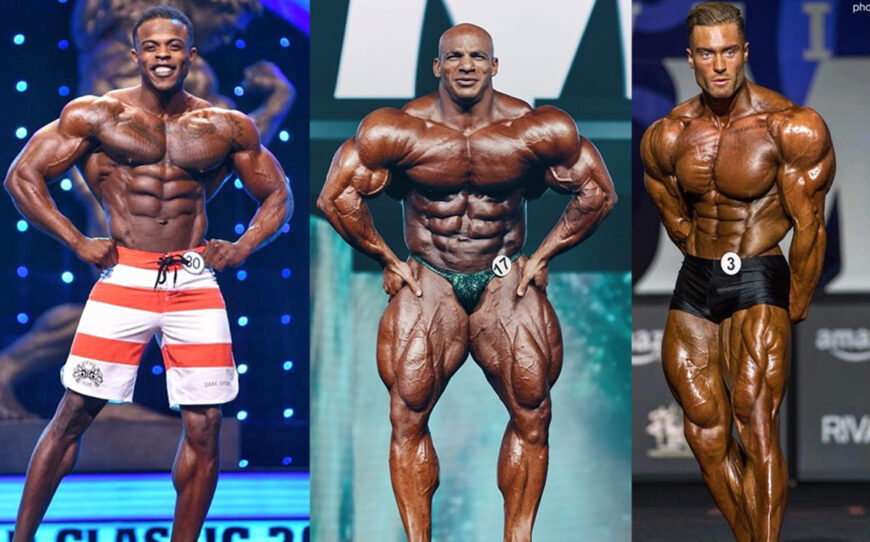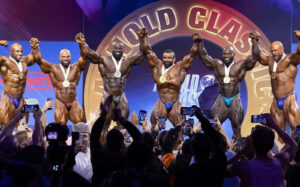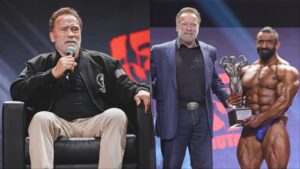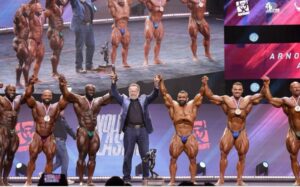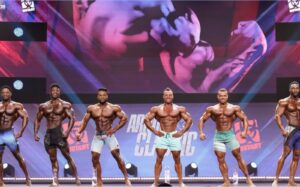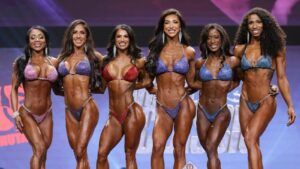Navigating the vast world of competitive bodybuilding can be quite daunting, especially when trying to understand the various divisions in Mr. Olympia. A remarkable fact is that there are 11 unique divisions under the IFBB Pro League, each with its distinct set of criteria and judging standards.
This blog post provides a comprehensive breakdown of these diverse categories – from Men’s Open Bodybuilding to Women’s Wellness – helping you better grasp this fascinating sport. Let’s dive in and demystify these bodybuilding areas one by one!
Key Takeaways
- Competitive bodybuilding has 11 different divisions under the IFBB Pro League umbrella, each with its own set of criteria and judging standards.
- The Men’s Open division allows athletes with massive muscularity to compete without weight or height restrictions, while the 212 Division is designed for shorter individuals with a strict weight limit of no more than 212 pounds.
- Classic Physique focuses on aesthetics from the golden era of bodybuilding, aiming for broad shoulders and a narrow waist, while Men’s Physique emphasizes upper body structure and athletic build over sheer muscle mass.
- In women’s divisions, Ms. Olympia showcases female bodybuilders’ dedication to building strength and achieving a well-defined physique, Fitness combines elements of bodybuilding with gymnastics and dance, Figure requires lean muscularity along with femininity in presentation, Bikini focuses on overall physique balance without excessive muscle development, Women’s Physique prioritizes shape and symmetry over sheer muscle mass, and Wellness offers a more muscular version of the bikini division focused on lower body aesthetics.
Understanding Competitive Bodybuilding Divisions
Competitive bodybuilding is no longer a one-size-fits-all sport. The International Federation of Bodybuilding and Fitness (IFBB) Pro League currently boasts 11 different divisions, each tailored to showcase unique athlete physiques.
These divisions don’t only differ in weight classes or height categories but also place varying emphasis on muscle size, proportion, and conditioning.
The Men’s Open division, for example, attracts athletes with massive muscularity as there are no weight or height restrictions. In stark contrast stands the 212 Division catered towards shorter individuals while still embracing significant muscle mass.
Classic Physique aims to bring back aesthetics from the golden era of bodybuilding focusing on genetically wide shoulders paired with a narrow waist. Lastly, Men’s Physique stresses importance on upper body structure over sheer muscle mass and puts shoulder to waist ratio into spotlight.
Men’s Bodybuilding Divisions
The men’s bodybuilding divisions in competitive bodybuilding include the Men’s Bodybuilding/Men’s Open Division, 212 Division or 212 Olympia, Classic Physique, Men’s Physique, and the Wheelchair division.
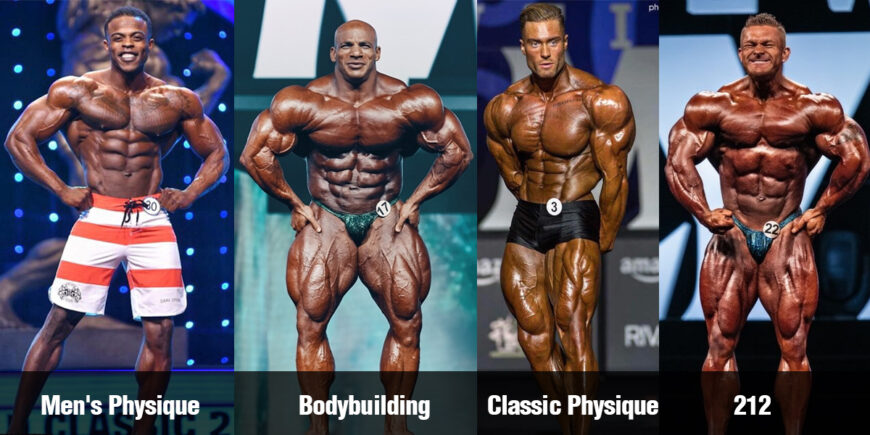
Men’s Open Bodybuilding or Mr. Olympia
The Men’s Bodybuilding division, known popularly as the Men’s Open Division, stands out as the largest and arguably most competitive category in the world of professional bodybuilding.
This pinnacle arena has no weight or height limitations, making it a fierce battleground for those seeking to represent the imposing blend of muscularity and symmetry at its absolute peak.
Contestants focus on developing large muscle groups alongside noticeable definition between these areas.
Flexing their muscles within this open forum are colossal competitors battling to be crowned king within the Mr. Olympia competition- one of great prestige in this field. Their comprehensive workout programs aid them towards building a physique that is not just big but finely crafted with detailed muscle separation and definition.
The intertwined nature of training, nutrition plans, and supplements make their mark here, shaping behemoths who dominate stages worldwide with their overwhelming size and outstanding conditioning.
212 Division or 212 Olympia
The 212 Division, also referred to as the 212 Olympia, represents a unique class in the competitive bodybuilding realm. Introduced specifically for shorter athletes, it’s designed to ensure fair play and equal opportunities amongst all competitors.
The key rule that defines this division is a strict weight limit of no more than 212 pounds per contestant. Despite being smaller in stature and having lower muscle mass than Men’s Open Bodybuilding competitors, athletes in this category still follow the same competition structure and are required to display similar attributes such as muscle balance, conditioning and symmetry.
So while these contestants may be lighter on the scales, they deliver an equally powerful performance filled with strength, agility and noteworthy muscularity.
Classic Physique
The Classic Physique division is all about bringing back the aesthetics of the golden era of bodybuilding. Competitors in this division strive to achieve a look similar to that of legendary bodybuilder Arnold Schwarzenegger.
The focus here is on broad shoulders, a narrow waist, and overall conditioning, symmetry, and size. Judges in this division are looking for vascularity, excellent stage presence, and a well-balanced physique.
Competitors in the Classic Physique division aim to achieve a timeless and iconic bodybuilding physique that pays homage to the past while still showcasing their own unique strengths.
Men’s Physique
Men’s Physique is a popular division in the world of competitive bodybuilding, specifically at events like Mr. Olympia. This category focuses on athletes who have a smaller and well-defined V-taper shape.
Unlike the competitors in the Open Bodybuilding division, Men’s Physique contestants do not aim to be as big and muscular. Instead, judges look for a balance between muscle size and definition.
These athletes work hard to achieve a physique that is aesthetic and proportionate, highlighting their athletic build without excessive bulk.
Wheelchair
The Wheelchair division is a specific category in the IFBB Pro League that caters to competitors who use wheelchairs. This division focuses on upper body muscle mass, conditioning, and symmetry when scoring participants.
It provides an opportunity for wheelchair users to showcase their strength and physical fitness on stage, highlighting their dedication to bodybuilding despite their unique circumstances.
Women’s Bodybuilding Divisions
The Women’s Bodybuilding divisions in competitive bodybuilding include Ms. Olympia, Fitness, Figure, Bikini, Women’s Physique, and Wellness.
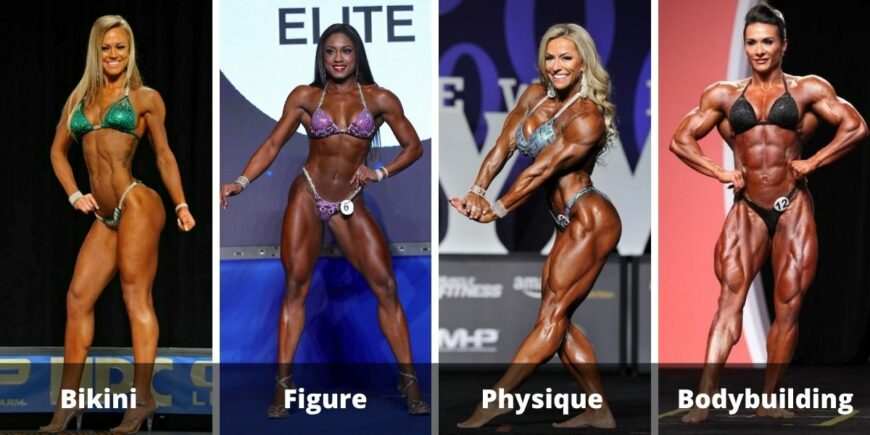
Women’s Bodybuilding (Ms. Olympia)
Women’s Bodybuilding, also known as Ms. Olympia, is a competitive division within the IFBB Pro League. This division focuses on showcasing the dedication and hard work of female bodybuilders.
Just like Men’s Open Bodybuilding, it is scored based on criteria such as size, muscle symmetry, and definition. Women in this division aim to develop muscularity and achieve a well-defined physique.
It provides a platform specifically designed for female athletes who have dedicated themselves to building strength and sculpting their bodies through rigorous training and nutrition programs.
Fitness
The fitness division in women’s bodybuilding is unique as it combines elements of bodybuilding, gymnastics, cheerleading, and dance. Competitors in the fitness division focus on building muscle size, definition, strength, and agility.
They are judged based on their overall physique development, muscular symmetry, and proportions. During competitions, fitness athletes perform a series of four quarter turns to showcase their athleticism and physique.
The judges evaluate them based on their muscle balance, shape, physical appearance, and overall presentation. It’s an exciting division that celebrates the fusion of strength and grace in women’s bodybuilding.
Figure
Figure competitors are an important part of the bodybuilding world. These athletes perform four quarter turns during their routine and are judged on various aspects of their physique development.
The judges look for muscular symmetry and proportions in figure competitors, as well as an overall lean and muscular body. However, it’s not just about muscle – figure competitors also need to show a feminine side with their physique.
In addition to having a muscular and lean body, figure competitors also put emphasis on stage presentation. including poise and overall presentation. It takes dedication and hard work to excel in the figure division of competitive bodybuilding competitions.
Bikini
The Bikini division is one of the 11 bodybuilding divisions in the IFBB Pro League. Competitors in this division should have a well-balanced physique with developed gluteal muscles.
Unlike other divisions, the Bikini division focuses on a softer body with toned condition and doesn’t require a clear six-pack or muscle separation. During competitions, competitors showcase their bodies in a bikini outfit.
It’s worth mentioning that the Bikini division is associated with the prestigious Mr. Olympia competition, adding to its significance in the world of competitive bodybuilding.
Women’s Physique
The Women’s Physique division in competitive bodybuilding focuses on creating a balanced and aesthetic physique. It prioritizes shape and symmetry over sheer muscle mass. Competitors are judged based on factors like proportion, muscle tone, poise, stage presence, and overall presentation.
The Women’s Physique division is closely related to the Men’s Classic Physique division and is one of the 11 divisions recognized by the IFBB Pro League for bodybuilding competitions.
Wellness
The Wellness division is a category within women’s bodybuilding competitions. It offers a more muscular version of the bikini division, with a focus on the lower body. Competitors in the Wellness division are judged on their muscle definition, tone, athleticism, symmetry, and stage presentation.
To excel in this division, women need to have a well-balanced physique with excellent muscle separation and definition. The Wellness division provides an opportunity for athletes to showcase their strength and aesthetics while maintaining femininity.
Explaining the Differences between Divisions
Discover the unique characteristics that set apart each division in competitive bodybuilding, from Men’s Open to Classic Physique and Women’s Bikini to Wellness.
Differences between 212 And Men’s Open Bodybuilding
The 212 Division and the Men’s Open division in bodybuilding have some key differences. Here are the main contrasts to note:
- Weight Restriction: The Men’s Open division has no weight restrictions, allowing competitors of any size to participate. In contrast, the 212 Division was specifically created for individuals who weigh 212 pounds or less.
- Height Limitations: While there are no height restrictions in the Men’s Open division, the 212 Division does not have a specific height requirement.
- Muscle Mass: Competitors in the Men’s Open division aim to build as much muscle mass as possible, focusing on size and overall muscularity. On the other hand, athletes in the 212 Division must carefully balance muscle mass with their weight limit, emphasizing a lean and proportionate physique.
- Proportions: In both divisions, judges assess competitors based on proportions and symmetry. However, due to the weight restriction in the 212 Division, athletes may need to prioritize certain muscle groups to maintain a balanced appearance while staying within their weight class.
- Aesthetics: While aesthetics play a role in both divisions, aesthetics tend to be more emphasized in the 212 Division since competitors cannot rely solely on sheer muscle size.
- Conditioning: Achieving optimal conditioning is crucial for success in both divisions. However, because of their size limitations, athletes in the 212 Division often need to attain higher levels of conditioning to enhance muscle definition and separation.
- Competition Level: The Men’s Open division typically attracts a larger field of competitors compared to the 212 Division. This means that competition may be stiffer and winning at this level requires exceptional dedication and hard work.
Differences between Men’s Physique & Classic Physique
The Men’s and Classic Physique divisions in competitive bodybuilding have distinct differences:
- Size: Men’s Open division has no weight or height restrictions, allowing competitors to focus on building maximum muscle mass. In contrast, Classic Physique emphasizes aesthetics and symmetry reminiscent of the golden era of bodybuilding.
- Proportions: Men’s Open division judges look for overall physical appearance, including muscle proportion, symmetry, and quality. Classic Physique competitors aim for a balanced upper and lower body development with a narrow waist and genetically wide shoulders.
- Muscle Definition: Men’s Open division places importance on muscle mass and conditioning. Classic Physique competitors strive for muscle separation, definition, and conditioning while maintaining a natural appearance.
- Presentation: Men’s Open division focuses on stage presence and the ability to display an overall developed physique. Classic Physique competitors pay attention to their poise, musculature, and overall presentation to evoke the classic bodybuilder look.
- Aesthetics: While both divisions value aesthetics, the approach differs. Men’s Open division prioritizes size and muscularity, often showcasing extreme development in specific muscles like chest, back, shoulders, arms, legs, and abs. Classic Physique aims for a more balanced aesthetic appeal with harmonious muscle development throughout the body.
- Judging Criteria: Judges in the Men’s Open division tend to favor bigger physiques with a heavy emphasis on muscle mass and size. In comparison, Classic Physique judges place more emphasis on proportions, symmetry, balance between muscle groups as well as paying respect to the classic posing style of bodybuilders from earlier eras.
- Overall Look: The difference can be seen in how men’s trunks are worn; Men’s Open competitors wear small trunks that often highlight their glutes while Classic Physique competitors wear longer trunks that cover more of their glutes while creating a more modest look.
Understanding the IFBB Pro League Bodybuilding Divisions
The IFBB Pro League consists of 11 different bodybuilding divisions, each with its own unique criteria and requirements. These divisions provide opportunities for athletes to compete based on their physique, size, and specific goals.
For example, the Men’s Open division is the most prestigious and competitive division in bodybuilding, with no weight or height restrictions. On the other hand, the 212 Division is specifically designed for shorter individuals who may struggle to accumulate as much muscle mass as taller competitors.
The Classic Physique division aims to bring back the aesthetics of the golden era of bodybuilding, focusing on proportions and overall balance. Additionally, there are divisions such as Men’s Physique which combine a muscular yet lean look with athleticism and aesthetics.
Another notable division is the Wheelchair division, where competitors who use wheelchairs are evaluated based on upper body muscle mass, symmetry, and conditioning. Understanding these various divisions within the IFBB Pro League is crucial for both athletes looking to compete and fans interested in following this exciting sport.
In summary:
- IFBB Pro League has 11 bodybuilding divisions.
- Men’s Open has no weight or height restrictions.
- 212 Division caters to shorter individuals.
- Classic Physique focuses on bringing back aesthetics from earlier eras.
- Men’s Physique combines muscularity with an athletic appearance.
- The Wheelchair division evaluates upper body muscle mass and symmetry.
- Women’s division includes: Women’s Bodybuilding, Women’s Physique, Figure, Fitness, Bikini and Wellness
Each division offers unique opportunities for athletes depending on their physique goals.
Insights into the National Physique Committee (NPC)
The National Physique Committee (NPC) is the amateur division of the International Federation of Bodybuilding and Fitness (IFBB). It serves as a stepping stone for aspiring bodybuilders who want to compete on a professional level.
The NPC offers various categories for both men and women, providing opportunities for individuals to showcase their physique and skills. For men, the NPC includes divisions such as Men’s Physique, Men’s Classic Physique, and Bodybuilding.
Women have divisions like Wellness, Figure, Bikini, and Women’s Physique. Competing in the NPC allows bodybuilders to gain experience, improve their skills, and potentially earn their professional status within the IFBB Pro League.
How the Divisions have Evolved Over the Years
The bodybuilding divisions have undergone significant changes and evolution over the years. Here are some key points to understand how the divisions have evolved:
- New divisions have been introduced, such as Classic Physique and Wellness, to cater to different body types and aesthetics.
- The Classic Physique division was created to bring back the aesthetic qualities of the golden era of bodybuilding.
- Women’s Bodybuilding has seen a decline in popularity over the years, leading to its removal from the Mr. Olympia competition for a period of time. However, it has recently made a comeback.
- The criteria for judging competitors have shifted focus from sheer muscle size to include factors like overall aesthetics, proportion, symmetry, and conditioning.
- The introduction of mandatory poses has become an important aspect of judging competitors in certain divisions.
- There has been an increased emphasis on marketability and stage presence, as well as overall presentation and poise.
- Differences in weight classes and height categories have been established to provide fair competition among athletes of similar physical attributes.
- Various bodybuilding federations and organizations have specific rules and regulations that govern their competitions.
FAQs
1. What are the different divisions in the Mr. Olympia competition?
The different divisions in the Mr. Olympia competition include Men’s Open, 212, Classic Physique, Men’s Physique, Ms. Olympia (Women’s Bodybuilding), Figure, Fitness, Women’s Physique, Bikini and Wellness division.
2. How does the Men’s Open division differ from the Classic Physique division?
The Men’s Open division allows for more mass and size, with competitors aiming to achieve extreme muscle development and definition. The Classic Physique division focuses on a more aesthetic and symmetrical physique reminiscent of bodybuilders from the past.
3. What weight class is included in the 212 division?
The 212 division requires competitors to weigh no more than 212 pounds (96 kilograms) at contest time, making it a category that showcases lean muscularity rather than sheer size.
4. Is women’s bodybuilding still a part of the Mr. Olympia competition?
Yes, women’s bodybuilding is still a part of the Mr. Olympia competition but it has undergone changes over time due to shifting trends and preferences within the fitness community.
Conclusion
In conclusion, understanding the different Mr. Olympia divisions is essential for both competitors and fans of bodybuilding. With a wide range of categories to suit various physique types and goals, these divisions showcase the diverse talents within the sport.
Whether it’s the mass and size of Men’s Open Bodybuilding or the aesthetics and symmetry of Classic Physique, each division has its own unique characteristics that make it exciting to watch and participate in.
So whether you’re aspiring to be a competitor or simply interested in learning more about the bodybuilding world, exploring these divisions will provide valuable insights into this dynamic sport.

